56 UMMA Objects
56 UMMA Objects
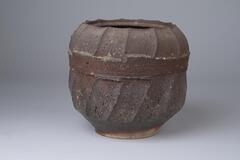
Jinnai Toru
Faceted Jar (Tea Ceremony Water Container or Mizusashi)
1960 – 1970
Gift of Ann Holmes
2013/1.308
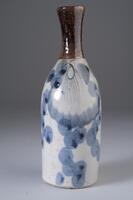
Japanese (Japanese (culture or style))
Small Sake Tokuri or Vase
1867 – 1932
Gift of Ann Holmes
2013/1.332
![Many dishes of this kind were produced in Jeollanam-do. The inner and outer surfaces of this dish have been coated in a thick layer of white slip. On the reverse side, slip has only been painted on the upper part, leaving exposed clay body towards the bottom. Seven spur marks remain on both the inner bottom and on the foot. Much slip has peeled off from the outer surface, which also features a large number of pinholes.<br />
[Korean Collection, University of Michigan Museum of Art (2014) p.157] Many dishes of this kind were produced in Jeollanam-do. The inner and outer surfaces of this dish have been coated in a thick layer of white slip. On the reverse side, slip has only been painted on the upper part, leaving exposed clay body towards the bottom. Seven spur marks remain on both the inner bottom and on the foot. Much slip has peeled off from the outer surface, which also features a large number of pinholes.<br />
[Korean Collection, University of Michigan Museum of Art (2014) p.157]](/media/W1siZiIsIjIwMjIvMDkvMjQvMjM5cnJ4eXVqaF9kZWZhdWx0LmpwZyJdLFsicCIsInRodW1iIiwiMjQweDIwMCJdXQ?sha=83c1702815da430f)
Korean (Korean (culture or style))
Ido chawan or shallow bowl
16th century
Gift of Bruce and Inta Hasenkamp and Museum purchase made possible by Elder and Mrs. Sang-Yong Nam
2004/1.272
![A glazed and speckled porcelain offering dish for an altar. The base is a wide decorated cylinder which tapers sharply into a narrow top. The base supports a wide, shallow bowl.<br />
<br />
This ritual dish was produced at a regional kiln. It is a low-quality object with a rough texture, made from the clay mixed with sand, contaminated with many impurities on the tray. Its glaze is dark with blue-green tints, giving the vessel the appearance of celadon. Its foot has an octagonal cross-section.<br />
[Korean Collection, University of Michigan Museum of Art (2014) p.200] A glazed and speckled porcelain offering dish for an altar. The base is a wide decorated cylinder which tapers sharply into a narrow top. The base supports a wide, shallow bowl.<br />
<br />
This ritual dish was produced at a regional kiln. It is a low-quality object with a rough texture, made from the clay mixed with sand, contaminated with many impurities on the tray. Its glaze is dark with blue-green tints, giving the vessel the appearance of celadon. Its foot has an octagonal cross-section.<br />
[Korean Collection, University of Michigan Museum of Art (2014) p.200]](/media/W1siZiIsIjIwMjIvMDkvMjQvNm45anZucHNldV9kZWZhdWx0LmpwZyJdLFsicCIsInRodW1iIiwiMjQweDIwMCJdXQ?sha=ccdbeadfd710d294)
Korean (Korean (culture or style))
Altar Dish
1850 – 1899
Gift of Ok Ja Chang and the Chang Family
2009/2.47
![<p>This celadon bowl is decorated with mold-impressed designs, which was one of popular type of dishes in 11th and 12th centuries. On its inner walls are lotus scroll designs, and on its inner base is what is presumed to be a lotus flower design. Glaze has been applied all the way down to the rim of the foot, which retains traces of silica supports in three places. The yellow-green glaze is evenly spread on the surface, while the clay is of specially selected high quality, producing a smooth surface.<br />
[<em>Korean Collection, University of Michigan Museum of Art</em> (2014) p.111]</p>
<br />
shallow lobed bowl with molded lotus design on wall, 6 lobes, very small foot, high quality, need cleaning <p>This celadon bowl is decorated with mold-impressed designs, which was one of popular type of dishes in 11th and 12th centuries. On its inner walls are lotus scroll designs, and on its inner base is what is presumed to be a lotus flower design. Glaze has been applied all the way down to the rim of the foot, which retains traces of silica supports in three places. The yellow-green glaze is evenly spread on the surface, while the clay is of specially selected high quality, producing a smooth surface.<br />
[<em>Korean Collection, University of Michigan Museum of Art</em> (2014) p.111]</p>
<br />
shallow lobed bowl with molded lotus design on wall, 6 lobes, very small foot, high quality, need cleaning](/media/W1siZiIsIjIwMjIvMDkvMjQvMmx1M2ptNHMzM19kZWZhdWx0LmpwZyJdLFsicCIsInRodW1iIiwiMjQweDIwMCJdXQ?sha=2ba2ecc35e4531c3)
Korean (Korean (culture or style))
Saucer with molded floral design in center and lining rim
1050 – 1150
Gift of Bruce and Inta Hasenkamp and Museum purchase made possible by Elder and Mrs. Sang-Yong Nam
2004/1.223
![<p>This octagonal dish is inlaid with a chrysanthemum design with white and black slip on each facet. Its outer base is entirely glazed and has three quartzite spur marks. The inner surface is undecorated but covered in crackles, revealing the gray body. The glaze was oxidized during ring, leaving many areas brown.<br />
[<em>Korean Collection, University of Michigan Museum of Art </em>(2014) p.117]<br />
</p>
<p>This octagonal dish is inlaid with a chrysanthemum design with white and black slip on each facet. Its outer base is entirely glazed and has three quartzite spur marks. The inner surface is undecorated but covered in crackles, revealing the gray body. The glaze was oxidized during ring, leaving many areas brown.<br />
[<em>Korean Collection, University of Michigan Museum of Art </em>(2014) p.117]<br />
</p>](/media/W1siZiIsIjIwMjIvMDkvMjQvNHVpbG92a2E1bl9kZWZhdWx0LmpwZyJdLFsicCIsInRodW1iIiwiMjQweDIwMCJdXQ?sha=811709a388c3f99f)
Korean (Korean (culture or style))
Octagonal faceted bowl with inlaid design of paired chrysanthemums on outer side
1250 – 1350
Gift of Bruce and Inta Hasenkamp and Museum purchase made possible by Elder and Mrs. Sang-Yong Nam
2004/1.234
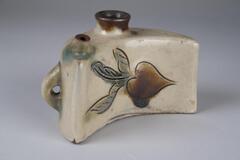
Japanese (Japanese (culture or style))
Small Hip Flask (Dachibin)
1933 – 1966
Gift of Ann Holmes
2013/1.301
Loading…

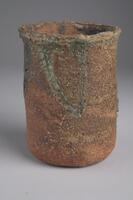
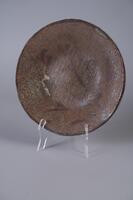
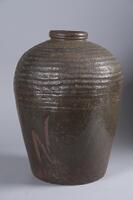
![This is a ritual dish assumed to have been produced at the private kiln near Bunwon-ri to supply the general pulic. The dish is deeper than the most other ritual vessels produced at the official court kilns, while the diameter of the mouth is small in relation to the maximum diameter of the foot. The clay and glaze are well fused. However, the the glazed surface has darkened due to the contamination by large amounts of ash. The base of the foot shows many traces of coarse sand supports. This type of ritual vessel with high foot is unique and simple in form that it was one of the Joseon ceramic vessels that was widely sought after by Western collectors.<br />
[Korean Collection, University of Michigan Museum of Art (2014) p.197] This is a ritual dish assumed to have been produced at the private kiln near Bunwon-ri to supply the general pulic. The dish is deeper than the most other ritual vessels produced at the official court kilns, while the diameter of the mouth is small in relation to the maximum diameter of the foot. The clay and glaze are well fused. However, the the glazed surface has darkened due to the contamination by large amounts of ash. The base of the foot shows many traces of coarse sand supports. This type of ritual vessel with high foot is unique and simple in form that it was one of the Joseon ceramic vessels that was widely sought after by Western collectors.<br />
[Korean Collection, University of Michigan Museum of Art (2014) p.197]](/media/W1siZiIsIjIwMjIvMDkvMjQvMnJ2dzIwdHZ0a19kZWZhdWx0LmpwZyJdLFsicCIsInRodW1iIiwiMjQweDIwMCJdXQ?sha=38d51954f86a9ca4)
